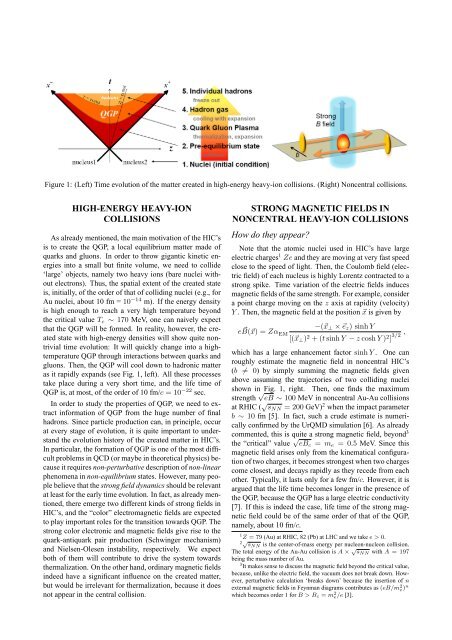Proceedings of International Conference on Physics in ... - KEK
Proceedings of International Conference on Physics in ... - KEK
Proceedings of International Conference on Physics in ... - KEK
Create successful ePaper yourself
Turn your PDF publications into a flip-book with our unique Google optimized e-Paper software.
Figure 1: (Left) Time evoluti<strong>on</strong> <str<strong>on</strong>g>of</str<strong>on</strong>g> the matter created <strong>in</strong> high-energy heavy-i<strong>on</strong> collisi<strong>on</strong>s. (Right) N<strong>on</strong>central collisi<strong>on</strong>s.<br />
HIGH-ENERGY HEAVY-ION<br />
COLLISIONS<br />
As already menti<strong>on</strong>ed, the ma<strong>in</strong> motivati<strong>on</strong> <str<strong>on</strong>g>of</str<strong>on</strong>g> the HIC’s<br />
is to create the QGP, a local equilibrium matter made <str<strong>on</strong>g>of</str<strong>on</strong>g><br />
quarks and glu<strong>on</strong>s. In order to throw gigantic k<strong>in</strong>etic energies<br />
<strong>in</strong>to a small but f<strong>in</strong>ite volume, we need to collide<br />
‘large’ objects, namely two heavy i<strong>on</strong>s (bare nuclei without<br />
electr<strong>on</strong>s). Thus, the spatial extent <str<strong>on</strong>g>of</str<strong>on</strong>g> the created state<br />
is, <strong>in</strong>itially, <str<strong>on</strong>g>of</str<strong>on</strong>g> the order <str<strong>on</strong>g>of</str<strong>on</strong>g> that <str<strong>on</strong>g>of</str<strong>on</strong>g> collid<strong>in</strong>g nuclei (e.g., for<br />
Au nuclei, about 10 fm = 10 −14 m). If the energy density<br />
is high enough to reach a very high temperature bey<strong>on</strong>d<br />
the critical value Tc ∼ 170 MeV, <strong>on</strong>e can naively expect<br />
that the QGP will be formed. In reality, however, the created<br />
state with high-energy densities will show quite n<strong>on</strong>trivial<br />
time evoluti<strong>on</strong>: It will quickly change <strong>in</strong>to a hightemperature<br />
QGP through <strong>in</strong>teracti<strong>on</strong>s between quarks and<br />
glu<strong>on</strong>s. Then, the QGP will cool down to hadr<strong>on</strong>ic matter<br />
as it rapidly expands (see Fig. 1, left). All these processes<br />
take place dur<strong>in</strong>g a very short time, and the life time <str<strong>on</strong>g>of</str<strong>on</strong>g><br />
QGP is, at most, <str<strong>on</strong>g>of</str<strong>on</strong>g> the order <str<strong>on</strong>g>of</str<strong>on</strong>g> 10 fm/c = 10 −22 sec.<br />
In order to study the properties <str<strong>on</strong>g>of</str<strong>on</strong>g> QGP, we need to extract<br />
<strong>in</strong>formati<strong>on</strong> <str<strong>on</strong>g>of</str<strong>on</strong>g> QGP from the huge number <str<strong>on</strong>g>of</str<strong>on</strong>g> f<strong>in</strong>al<br />
hadr<strong>on</strong>s. S<strong>in</strong>ce particle producti<strong>on</strong> can, <strong>in</strong> pr<strong>in</strong>ciple, occur<br />
at every stage <str<strong>on</strong>g>of</str<strong>on</strong>g> evoluti<strong>on</strong>, it is quite important to understand<br />
the evoluti<strong>on</strong> history <str<strong>on</strong>g>of</str<strong>on</strong>g> the created matter <strong>in</strong> HIC’s.<br />
In particular, the formati<strong>on</strong> <str<strong>on</strong>g>of</str<strong>on</strong>g> QGP is <strong>on</strong>e <str<strong>on</strong>g>of</str<strong>on</strong>g> the most difficult<br />
problems <strong>in</strong> QCD (or maybe <strong>in</strong> theoretical physics) because<br />
it requires n<strong>on</strong>-perturbative descripti<strong>on</strong> <str<strong>on</strong>g>of</str<strong>on</strong>g> n<strong>on</strong>-l<strong>in</strong>ear<br />
phenomena <strong>in</strong> n<strong>on</strong>-equilibrium states. However, many people<br />
believe that the str<strong>on</strong>g field dynamics should be relevant<br />
at least for the early time evoluti<strong>on</strong>. In fact, as already menti<strong>on</strong>ed,<br />
there emerge two different k<strong>in</strong>ds <str<strong>on</strong>g>of</str<strong>on</strong>g> str<strong>on</strong>g fields <strong>in</strong><br />
HIC’s, and the “color” electromagnetic fields are expected<br />
to play important roles for the transiti<strong>on</strong> towards QGP. The<br />
str<strong>on</strong>g color electr<strong>on</strong>ic and magnetic fields give rise to the<br />
quark-antiquark pair producti<strong>on</strong> (Schw<strong>in</strong>ger mechanism)<br />
and Nielsen-Olesen <strong>in</strong>stability, respectively. We expect<br />
both <str<strong>on</strong>g>of</str<strong>on</strong>g> them will c<strong>on</strong>tribute to drive the system towards<br />
thermalizati<strong>on</strong>. On the other hand, ord<strong>in</strong>ary magnetic fields<br />
<strong>in</strong>deed have a significant <strong>in</strong>fluence <strong>on</strong> the created matter,<br />
but would be irrelevant for thermalizati<strong>on</strong>, because it does<br />
not appear <strong>in</strong> the central collisi<strong>on</strong>.<br />
STRONG MAGNETIC FIELDS IN<br />
NONCENTRAL HEAVY-ION COLLISIONS<br />
How do they appear?<br />
Note that the atomic nuclei used <strong>in</strong> HIC’s have large<br />
electric charges 1 Ze and they are mov<strong>in</strong>g at very fast speed<br />
close to the speed <str<strong>on</strong>g>of</str<strong>on</strong>g> light. Then, the Coulomb field (electric<br />
field) <str<strong>on</strong>g>of</str<strong>on</strong>g> each nucleus is highly Lorentz c<strong>on</strong>tracted to a<br />
str<strong>on</strong>g spike. Time variati<strong>on</strong> <str<strong>on</strong>g>of</str<strong>on</strong>g> the electric fields <strong>in</strong>duces<br />
magnetic fields <str<strong>on</strong>g>of</str<strong>on</strong>g> the same strength. For example, c<strong>on</strong>sider<br />
a po<strong>in</strong>t charge mov<strong>in</strong>g <strong>on</strong> the z axis at rapidity (velocity)<br />
Y . Then, the magnetic field at the positi<strong>on</strong> ⃗x is given by<br />
e ⃗ B(⃗x) = Zα EM<br />
−(⃗x⊥ × ⃗ez) s<strong>in</strong>h Y<br />
[(⃗x⊥) 2 + (t s<strong>in</strong>h Y − z cosh Y ) 2 ,<br />
3/2<br />
]<br />
which has a large enhancement factor s<strong>in</strong>h Y . One can<br />
roughly estimate the magnetic field <strong>in</strong> n<strong>on</strong>central HIC’s<br />
(b ̸= 0) by simply summ<strong>in</strong>g the magnetic fields given<br />
above assum<strong>in</strong>g the trajectories <str<strong>on</strong>g>of</str<strong>on</strong>g> two collid<strong>in</strong>g nuclei<br />
shown <strong>in</strong> Fig. 1, right. Then, <strong>on</strong>e f<strong>in</strong>ds the maximum<br />
strength √ eB ∼ 100 MeV <strong>in</strong> n<strong>on</strong>central Au-Au collisi<strong>on</strong>s<br />
at RHIC ( √ sNN = 200 GeV) 2 when the impact parameter<br />
b ∼ 10 fm [5]. In fact, such a crude estimate is numerically<br />
c<strong>on</strong>firmed by the UrQMD simulati<strong>on</strong> [6]. As already<br />
commented, this is quite a str<strong>on</strong>g magnetic field, bey<strong>on</strong>d 3<br />
the “critical” value √ eBc = me = 0.5 MeV. S<strong>in</strong>ce this<br />
magnetic field arises <strong>on</strong>ly from the k<strong>in</strong>ematical c<strong>on</strong>figurati<strong>on</strong><br />
<str<strong>on</strong>g>of</str<strong>on</strong>g> two charges, it becomes str<strong>on</strong>gest when two charges<br />
come closest, and decays rapidly as they recede from each<br />
other. Typically, it lasts <strong>on</strong>ly for a few fm/c. However, it is<br />
argued that the life time becomes l<strong>on</strong>ger <strong>in</strong> the presence <str<strong>on</strong>g>of</str<strong>on</strong>g><br />
the QGP, because the QGP has a large electric c<strong>on</strong>ductivity<br />
[7]. If this is <strong>in</strong>deed the case, life time <str<strong>on</strong>g>of</str<strong>on</strong>g> the str<strong>on</strong>g magnetic<br />
field could be <str<strong>on</strong>g>of</str<strong>on</strong>g> the same order <str<strong>on</strong>g>of</str<strong>on</strong>g> that <str<strong>on</strong>g>of</str<strong>on</strong>g> the QGP,<br />
namely, about 10 fm/c.<br />
1 Z = 79 (Au) at RHIC, 82 (Pb) at LHC and we take e > 0.<br />
2 √ sNN is the center-<str<strong>on</strong>g>of</str<strong>on</strong>g>-mass energy per nucle<strong>on</strong>-nucle<strong>on</strong> collisi<strong>on</strong>.<br />
The total energy <str<strong>on</strong>g>of</str<strong>on</strong>g> the Au-Au collisi<strong>on</strong> is A × √ sNN with A = 197<br />
be<strong>in</strong>g the mass number <str<strong>on</strong>g>of</str<strong>on</strong>g> Au.<br />
3 It makes sense to discuss the magnetic field bey<strong>on</strong>d the critical value,<br />
because, unlike the electric field, the vacuum does not break down. However,<br />
perturbative calculati<strong>on</strong> ‘breaks down’ because the <strong>in</strong>serti<strong>on</strong> <str<strong>on</strong>g>of</str<strong>on</strong>g> n<br />
external magnetic fields <strong>in</strong> Feynman diagrams c<strong>on</strong>tributes as (eB/m 2 e )n<br />
which becomes order 1 for B > Bc = m 2 e/e [3].













